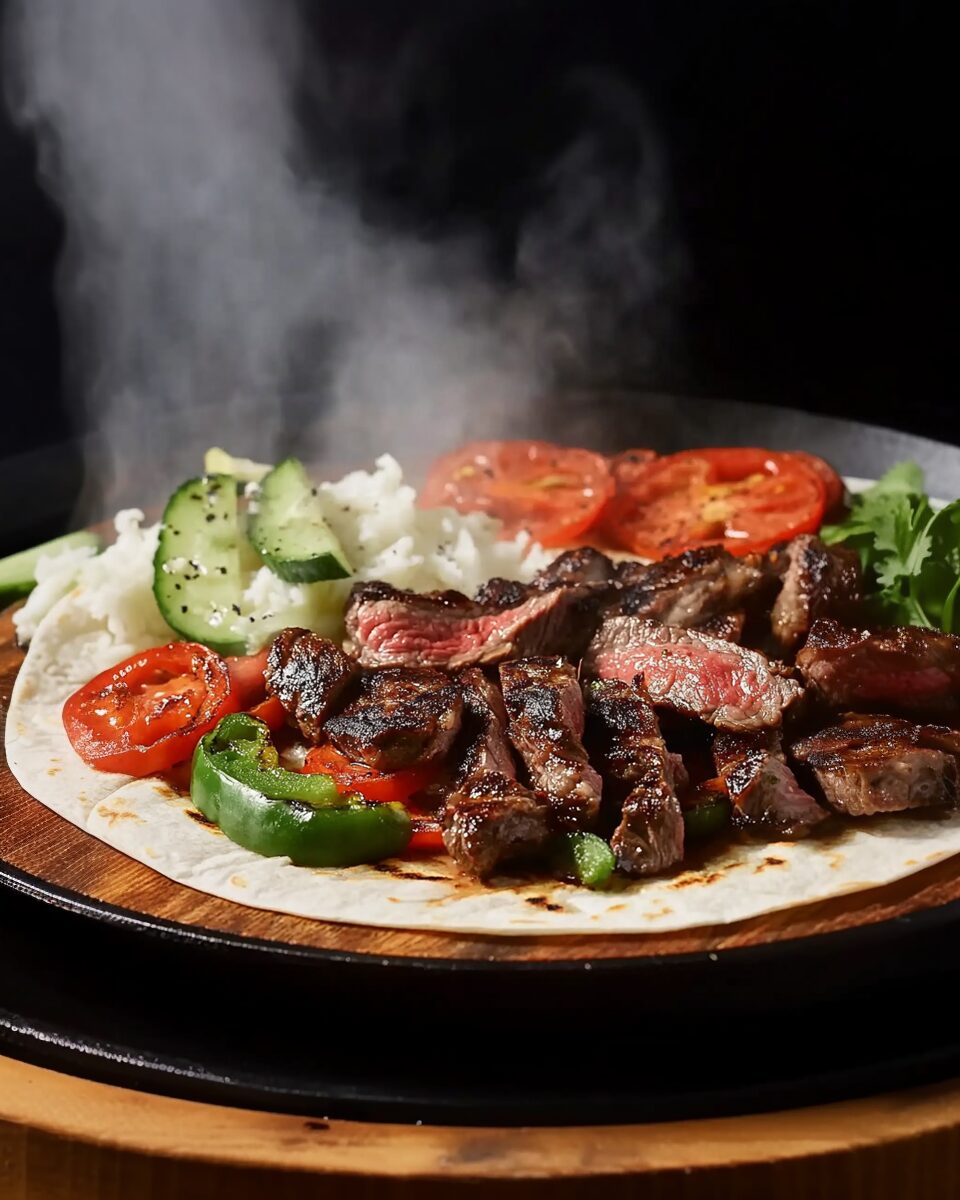Get ready to spice up your dinner table with these mouthwatering Steak Fajitas! Perfectly seasoned, tender slices of steak combined with colorful bell peppers and onions make a delicious, quick, and easy meal that’s better than any restaurant version. Whether you’re hosting a gathering or just craving something flavorful on a weeknight, this recipe is a winner.
Full Recipe:
Ingredients
- 1 ½ pounds skirt steak or flank steak
- 3 tablespoons olive oil, divided
- 1 teaspoon chili powder
- 1 teaspoon smoked paprika
- 1 teaspoon ground cumin
- 1 teaspoon garlic powder
- 1 teaspoon onion powder
- ½ teaspoon kosher salt
- ½ teaspoon ground black pepper
- 1 red bell pepper, sliced
- 1 yellow bell pepper, sliced
- 1 green bell pepper, sliced
- 1 large onion, sliced
- 8 small flour tortillas
- Optional toppings: sour cream, salsa, guacamole, shredded cheese, chopped cilantro, lime wedges
Directions
- Place the steak in a large dish or zip-top bag.
- In a small bowl, combine 2 tablespoons olive oil, chili powder, smoked paprika, cumin, garlic powder, onion powder, salt, and pepper.
- Rub the seasoning mixture all over the steak. Let it marinate for at least 30 minutes, or refrigerate for up to 24 hours.
- Heat 1 tablespoon olive oil in a large skillet over medium-high heat. Add the steak and cook for about 3-4 minutes per side for medium-rare or until desired doneness.
- Remove the steak and let it rest for 5 minutes. Then slice it thinly against the grain.
- In the same skillet, add the bell peppers and onion. Cook for 4-5 minutes or until they are slightly tender but still crisp.
- Return the sliced steak to the skillet and stir everything together to combine and heat through.
- Warm the tortillas and serve the steak and veggies with your favorite toppings.
Nutrients
(Per serving, without optional toppings)
- Calories: 410
- Protein: 28g
- Fat: 20g
- Saturated Fat: 5g
- Carbohydrates: 29g
- Fiber: 3g
- Sugar: 4g
- Sodium: 580mg
- Cholesterol: 70mg
The History of Fajitas
Fajitas have their roots in the cuisine of Texas, particularly among the Mexican-American communities. The story of fajitas begins with the ranch workers in Texas in the 1930s. They were given cuts of meat that were less desirable and tougher, such as skirt steak, which were often the by-products of butchering cattle. These workers marinated the tough meat, grilled it, and sliced it into thin strips to make it more tender and palatable.
As the fajita gained popularity, especially in the 1970s and 1980s, it evolved into the version we recognize today, with vibrant bell peppers and onions sautéed alongside the beef, and served in warm tortillas. Over time, fajitas expanded beyond beef to include chicken, shrimp, and even vegetarian options, offering a variety of choices for people with different dietary preferences.
Today, steak fajitas are a staple of Tex-Mex and Mexican cuisine and are widely enjoyed across the United States and beyond. They are often served in sizzling skillets at restaurants, a visual presentation that adds to their appeal.
Flavor Profile: What Makes Steak Fajitas So Delicious
The irresistible flavor of steak fajitas comes from the combination of perfectly cooked beef, sautéed vegetables, and a blend of bold spices. The seasoning mix typically includes chili powder, cumin, garlic powder, smoked paprika, and other ingredients that complement the beef’s rich taste. These spices provide a smoky, slightly spicy flavor without overpowering the natural taste of the steak.
The steak itself, when cooked properly, offers a tender and juicy bite. The high heat used to cook the steak quickly seals in the juices, ensuring that each slice remains flavorful and moist. The thin slices of steak also absorb the seasoning well, making every bite flavorful.
The vegetables—usually a mix of colorful bell peppers and onions—add a sweet, slightly caramelized contrast to the savory steak. The vegetables are often sautéed in the same pan as the steak, absorbing the flavorful remnants of the meat and spices, making them an integral part of the dish.
Finally, the flour tortillas, typically soft and slightly chewy, serve as the perfect vehicle to carry the steak and veggies, making it easy to enjoy all the flavors in each bite. Optional toppings like guacamole, salsa, sour cream, and shredded cheese enhance the fajitas even further, adding richness, tang, and freshness.
Nutritional Benefits of Steak Fajitas
Steak fajitas offer a variety of nutritional benefits, especially when made with lean cuts of meat and plenty of vegetables. Here’s a breakdown of the key nutrients you can expect from this dish:
-
Protein: Steak is a rich source of high-quality protein, essential for muscle growth, repair, and overall body function. A serving of steak fajitas provides a significant amount of protein, helping to keep you full and satisfied.
-
Iron: Beef is an excellent source of iron, an essential mineral that helps carry oxygen throughout the body and supports the immune system.
-
Vitamins and Minerals: Bell peppers and onions are packed with essential vitamins and minerals, including vitamin C, which supports immune function and promotes healthy skin. Onions also contain antioxidants that help fight inflammation and support heart health.
-
Healthy Fats: If you use olive oil or avocado oil to cook your fajitas, you’re incorporating healthy fats into your meal, which are beneficial for heart health.
-
Carbohydrates: While the primary focus of the dish is the protein and vegetables, the flour tortillas provide a source of carbohydrates, which are the body’s main energy source.
To make steak fajitas even healthier, you can opt for whole-wheat tortillas, which add fiber, or serve the fajitas in a lettuce wrap for a low-carb alternative.
How to Make the Perfect Steak Fajitas
While the recipe for steak fajitas is relatively simple, the key to making them perfect lies in the details. Here are some tips for ensuring that your fajitas come out tender, flavorful, and satisfying every time:
-
Choose the Right Cut of Beef: Skirt steak is the traditional cut used for fajitas, but flank steak or other cuts of beef like sirloin or ribeye can also work. The key is to choose a cut that has some marbling, as the fat adds flavor and helps keep the meat moist.
-
Marinate the Meat: Marinating the steak helps infuse it with flavor and tenderize it. Even a short marinating time of 30 minutes can make a difference, but if you have time, marinating for a few hours or overnight will result in even more tender meat.
-
Cook on High Heat: To get the perfect sear on the steak, cook it on high heat for just a few minutes per side. This locks in the juices and creates a nice crust on the outside while keeping the inside tender.
-
Rest the Steak: After cooking, allow the steak to rest for a few minutes before slicing. This helps the juices redistribute, ensuring that the meat stays juicy and flavorful.
-
Use Fresh Vegetables: The bell peppers and onions should be crisp-tender, not overcooked. Sauté them just until they start to soften but still have a bit of crunch to retain their fresh flavor.
Creative Variations of Steak Fajitas
While the classic steak fajitas recipe is delicious on its own, there are many ways to get creative with this dish. Here are a few variations that can add new twists to your fajita experience:
-
Vegetarian Fajitas: Replace the steak with portobello mushrooms, zucchini, or eggplant for a delicious vegetarian alternative. The mushrooms have a meaty texture that holds up well when grilled or sautéed.
-
Chicken Fajitas: For a leaner option, use boneless, skinless chicken breasts or thighs instead of beef. Chicken fajitas are just as flavorful and versatile as the traditional version.
-
Shrimp Fajitas: For seafood lovers, shrimp makes a great substitute for steak. Shrimp cooks quickly and absorbs the fajita seasoning beautifully, making for a light but flavorful meal.
-
Fajita Bowls: If you’re looking for a low-carb or gluten-free option, try making fajita bowls by serving the steak and vegetables over a bed of rice or lettuce instead of using tortillas.
-
Spicy Fajitas: Add some heat to your fajitas by incorporating jalapeños, hot sauce, or spicy chili peppers into the marinade or as a topping.
Serving Suggestions
Steak fajitas are a versatile dish that pairs well with a variety of sides and accompaniments. Some great options include:
-
Mexican Rice or Spanish Rice: A flavorful rice dish with a hint of tomato and spices complements the fajitas perfectly.
-
Refried Beans: Creamy and savory refried beans add richness to the meal and help balance out the flavors.
-
Guacamole and Salsa: Fresh guacamole and salsa are perfect toppings to add an extra layer of flavor and texture.
-
Grilled Corn: Sweet, grilled corn on the cob or a corn salad can enhance the meal with a slightly smoky flavor.
-
Cilantro Lime Rice: Rice tossed with cilantro and lime adds a refreshing, zesty contrast to the richness of the steak.
Conclusion
Steak fajitas are a timeless dish that offers a perfect combination of tender steak, crisp vegetables, and bold spices. Whether you’re a fan of the classic recipe or enjoy experimenting with different variations, fajitas are sure to satisfy your taste buds.






